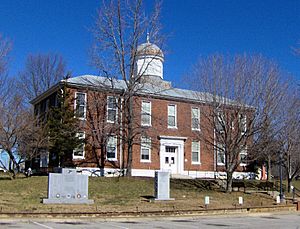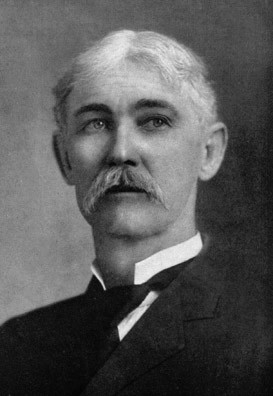Dickson County, Tennessee facts for kids
Quick facts for kids
Dickson County
|
||
|---|---|---|

Dickson County Courthouse in Charlotte
|
||
|
||

Location within the U.S. state of Tennessee
|
||
 Tennessee's location within the U.S. |
||
| Country | ||
| State | ||
| Founded | October 25, 1803 | |
| Named for | William Dickson | |
| Seat | Charlotte | |
| Largest city | Dickson | |
| Area | ||
| • Total | 491 sq mi (1,270 km2) | |
| • Land | 490 sq mi (1,300 km2) | |
| • Water | 1.4 sq mi (4 km2) 0.3%% | |
| Population
(2020)
|
||
| • Total | 54,315 | |
| • Estimate
(2023)
|
56,729 |
|
| • Density | 110.62/sq mi (42.71/km2) | |
| Time zone | UTC−6 (Central) | |
| • Summer (DST) | UTC−5 (CDT) | |
| Area code | 615 | |
| Congressional district | 7th | |
Dickson County is a county in the state of Tennessee. In 2020, about 54,315 people lived here. Its main town, or county seat, is Charlotte.
Dickson County is part of the larger Nashville-Davidson–Murfreesboro–Franklin area. It is home to Tennessee's oldest courthouse that is still in use today. This building was built in 1835. The first courthouse was a log building. It was destroyed by a tornado in 1833.
History of Dickson County
Charlotte is the county's main town. It was built on land bought from Charles Stewart. A tornado in 1833 almost completely destroyed Charlotte. It ruined the jail, courthouse, and most of the county's records.
On October 25, 1803, the Tennessee General Assembly created Dickson County. It was the 25th of Tennessee's 95 counties. The county was named after William Dickson. He was a doctor from Nashville and a member of the United States Congress.
The county officially started on March 19, 1804. Early court meetings were held in people's homes. A courthouse was built in 1810.
Dickson County was a popular place for settlers. It was near the Piney and Cumberland rivers. At first, cotton was a major crop. Later, rye, oats, corn, and tobacco became more important.
General James Robertson built the first ironworks in west Tennessee here. In 1804, Montgomery Bell bought it. Later, Anthony Wayne Van Leer bought it. The town of Vanleer, TN is named after his family. Many people who worked in the iron industry were enslaved. Iron making became less important after the American Civil War. However, some iron furnaces were still working in the 1940s.
A county school board started in 1807. But public education did not get much support in the 1800s. Some early schools included Tracy Academy and Charlotte Female School.
On June 8, 1861, the county voted to join the Confederacy. Dickson County sent six groups of soldiers and an artillery unit to the South. No big battles happened here. But Union railroads were often attacked.
New railroads were built through the county's southern part. This brought many new people to the area. They settled in new towns like Dickson, Tennessee City, White Bluff, and Burns. Dickson became a major railroad center. By the early 1900s, it was the main business and cultural hub. Dickson grew bigger than Charlotte. This caused arguments about which town should be the county seat.
In 1917, people met in Dickson to raise money. They wanted to pay for a new highway through the county. They raised the money very quickly. This highway, Highway 70, became known as the "Broadway of America."
Montgomery Bell State Park is a popular recreation area. It was built in 1942. After World War II, the state of Tennessee took over running the park.
The Ruskin Colony
The Ruskin Colony was a special community. About 250 people lived there. They believed in a type of socialism. This meant they tried to share everything and work together. It started in Dickson County in 1894. The colony broke up by 1899 because of disagreements.
A socialist newspaper called The Coming Nation moved to the Ruskin Colony. This paper later became Appeal to Reason. It was a very popular socialist newspaper in the United States. It supported farmers and workers. By 1910, it had over half a million readers.
Governor Frank G. Clement
Frank G. Clement (1920–1969) was from Dickson. On November 4, 1952, he was elected Governor of Tennessee. He served as governor from 1953 to 1959, and again from 1963 to 1967. He was known for his powerful speeches. He gave a major speech at the 1956 Democratic National Convention.
The Hotel Halbrook is in Dickson. This is where Clement was born. Today, it is a museum. It is listed on the National Register of Historic Places.
Geography
Dickson County covers about 491 square miles. Most of this area is land. Only a small part is water.
The Cumberland River forms part of the county's northeast border. The Harpeth River flows along its eastern side. Ruskin Cave is a famous spot. It is located about 8 miles northwest of Dickson.
Neighboring Counties
- Montgomery County (north)
- Cheatham County (east)
- Williamson County (southeast)
- Hickman County (south)
- Humphreys County (southwest)
- Houston County (northwest)
Protected Areas
- Cheatham Lake Wildlife Management Area (part)
- Hotel Halbrook Railroad and Local History Museum (state historic site)
- Montgomery Bell State Natural Area
- Montgomery Bell State Park
Population Information
| Historical population | |||
|---|---|---|---|
| Census | Pop. | %± | |
| 1810 | 4,516 | — | |
| 1820 | 5,190 | 14.9% | |
| 1830 | 7,265 | 40.0% | |
| 1840 | 7,074 | −2.6% | |
| 1850 | 8,404 | 18.8% | |
| 1860 | 9,982 | 18.8% | |
| 1870 | 9,340 | −6.4% | |
| 1880 | 12,460 | 33.4% | |
| 1890 | 13,645 | 9.5% | |
| 1900 | 18,635 | 36.6% | |
| 1910 | 19,955 | 7.1% | |
| 1920 | 19,342 | −3.1% | |
| 1930 | 18,491 | −4.4% | |
| 1940 | 19,718 | 6.6% | |
| 1950 | 18,805 | −4.6% | |
| 1960 | 18,839 | 0.2% | |
| 1970 | 21,977 | 16.7% | |
| 1980 | 30,037 | 36.7% | |
| 1990 | 35,061 | 16.7% | |
| 2000 | 43,156 | 23.1% | |
| 2010 | 49,666 | 15.1% | |
| 2020 | 54,315 | 9.4% | |
| 2023 (est.) | 56,729 | 14.2% | |
| U.S. Decennial Census 1790-1960 1900-1990 1990-2000 2010-2014 |
|||
2020 Census Details
| Group | Number | Percentage |
|---|---|---|
| White (not Hispanic) | 46,994 | 86.52% |
| Black or African American (not Hispanic) | 1,931 | 3.56% |
| Native American | 181 | 0.33% |
| Asian | 310 | 0.57% |
| Pacific Islander | 4 | 0.01% |
| Other/Mixed | 2,313 | 4.26% |
| Hispanic or Latino | 2,582 | 4.75% |
In 2020, there were 54,315 people living in Dickson County. These people lived in 19,198 households. There were also 13,030 families.
Education
The Dickson County School District serves all students in the county. As of 2024, Dr. Christie Southerland is the Director of Schools.
The school system has about 8,500 students. This makes it the 23rd largest school district in Tennessee. Around 1,200 people work for the district.
School Board
The Dickson County Board of Education runs the county's schools. It has six elected members. Each member represents one of the six areas in Dickson County. The Board makes decisions about how the schools operate. They usually meet on the fourth Thursday of each month.
The Board also chooses the Director of Schools. Dr. Christie Southerland has been the Director since 2024.
| District | Name | Notes |
|---|---|---|
| 1 | Kirk Vandivort | Chair |
| 2 | Sonya Brogdon | |
| 3 | Steve Haley | |
| 4 | Phil Chadwick | |
| 5 | Joe Underwood | |
| 6 | Aaron Parker |
School History
Before the 1920s, Dickson County had many private high schools and colleges. Some of these were Tracy Academy and Dickson Normal School. Hattie Carraway, the first woman elected to the U.S. Senate, studied at Dickson Normal School. Most of these schools closed during the Great Depression. Today, all public schools in the county are run by one school district.
Schools in Dickson County
The Dickson County Board of Education runs 16 schools:
Elementary Schools
- Centennial
- Charlotte
- Dickson
- Oakmont
- The Discovery School
- Sullivan
- Stuart-Burns
- Vanleer
- White Bluff
Middle Schools
- Charlotte
- Burns
- Dickson
- William James
High Schools
- Creek Wood
- Dickson County
Alternative School
- New Directions Academy
Higher Education
Dickson County also has two colleges:
The Tennessee College of Applied Technology – Dickson offers training for many jobs. You can learn about car repair, computer skills, cosmetology, and health programs. They also teach digital graphic design, HVAC, and welding.
Nashville State Community College has a campus in Dickson. Here, students can earn associate degrees. These degrees can help them transfer to a four-year university. Or they can help students get ready for a job.
Communities
Cities
Towns
- Burns
- Charlotte (county seat)
- Slayden
- Vanleer
- White Bluff
Unincorporated communities
See also
 In Spanish: Condado de Dickson para niños
In Spanish: Condado de Dickson para niños




